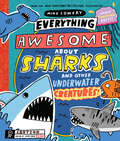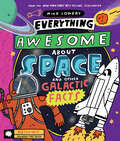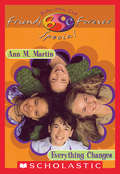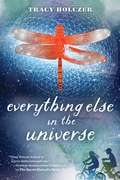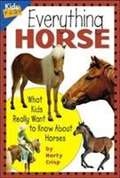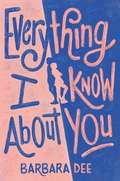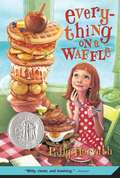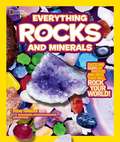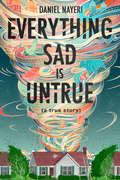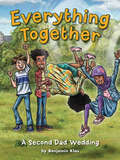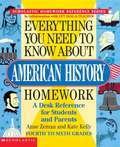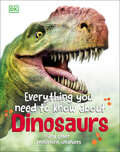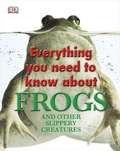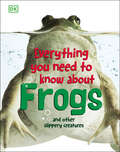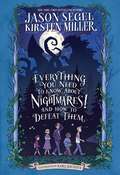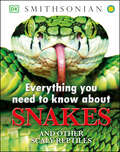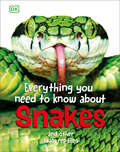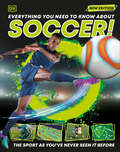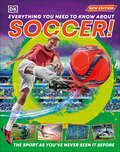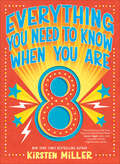- Table View
- List View
Everyday Spelling (Grade #5)
by James Beers W. Dorsey Hammond Ronald L CramerYou can conquer long words by dividing them into short parts.
Everything Awesome About Dinosaurs and Other Prehistoric Beasts! (Everything Awesome About)
by Mike LoweryFrom the creative brain of Mike Lowery, discover the ULTIMATE book about all things prehistoric! Featuring fun facts, dinosaur jokes, comics, timelines, and more!The Boys' Book of Survival meets Dav Pilkey with a prehistoric twist, in this definitive, go-to book about EVERYTHING you EVER wanted to know about dinosaurs. Discover a wealth of weird, wacky, and wild facts about dinosaurs, told in Mike Lowery's signature comic style with bright and energetic artwork, fresh framing devices, and hilarious jokes. This will be the go-to book for dinosaur enthusiasts that kids will put in their backpacks and obsess over, bridging the gap between encyclopedic nonfiction content and lighter picture book fare, filling the need with a one-stop shop for the legions of 6-9 year olds who want to know absolutely everything there is to know about dinosaurs.Discover the must-have book for dinosaur enthusiasts, a madcap field guide full of facts and humor, and learn everything you ever wanted to know about prehistoric beasts!
Everything Awesome About Sharks and Other Underwater Creatures! (Everything Awesome About)
by Mike LoweryDiscover the ULTIMATE, 128-paged book about all things sharks and underwater creatures, from the creative brain of Mike Lowery! Featuring fun facts, jokes, comics, maps, and more.Did you know that sharks can be as small as a banana, or bigger than a bus? Or that whale sharks have more than 3,000 teeth? Did you know that giant squids have eyes the size of dinner plates? Or that clownfish are protected by snot armor?? Find out all this and more, in this comprehensive, hilarious underwater deep dive from Mike Lowery!For fans of Dog Man who love nonfiction, discover this definitive, go-to book about everything AWESOME you EVER wanted to know about all things under the sea. Uncover a wealth of weird, wacky, and wild facts about sharks and underwater creatures, told in Mike Lowery's signature, acclaimed comic style with bright and energetic artwork, fresh framing devices, and hilarious jokes. This is the go-to book for shark enthusiasts that kids will put in their backpacks and obsess over, bridging the gap between encyclopedic nonfiction content and lighter picture book fare, filling the need with a one-stop shop for the legions of 7-10 year olds who want to know absolutely everything there is to know about underwater creatures.Discover the must-have book for shark fanatics, a madcap field guide full of facts and humor, and learn everything you ever wanted to know about underwater creatures!
Everything Awesome About Space and Other Galactic Facts!
by Mike LoweryBlast off into outer space with this ultimate, 128-page book about everything you ever wanted to know about the universe, jam-packed with fun facts, jokes, comics, and more!Did you know that the surface of the sun is hot enough to make diamonds boil? Or that one year on Neptune is 165 Earth years? Or that space is thought to smell like... burnt steak?? Find out all this and more, in this comprehensive, hilarious outer space adventure from Mike Lowery!Perfect for fans of Dog Man who love nonfiction, this is the definitive, go-to book about everything AWESOME you EVER wanted to know about all things outer space Uncover a wealth of weird, wacky, and wild facts about our universe, from planets to supernovas to space travel and everything in-between, told in Mike Lowery's signature, acclaimed comic style with bright and energetic artwork, fresh framing devices, and hilarious jokes. This is the go-to book for space enthusiasts that kids will put in their backpacks and obsess over, bridging the gap between encyclopedic nonfiction content and lighter picture book fare, filling the need with a one-stop shop for the legions of 7-10 year olds who want to know absolutely everything there is to know about space.This book joins Everything Awesome About Dinosaurs and Other Prehistoric Beasts and Everything Awesome About Sharks and Other Underwater Creatures in this groundbreaking nonfiction series, covering the topics that kids love with a fresh and one-of-a-kind graphic novel approach. Discover the must-have, out-of-this-world guide for space fanatics, a madcap field guide full of facts and humor, and learn everything you ever wanted to know about outer space!
Everything Changes (Baby-Sitters Club Friends Forever Super Special #1)
by Ann M. MartinIt's a summer of change for the "Baby-Sitters Club", with major changes in the look and focus of Ann M. Martin's classic series. Throughout the summer members of the club share feelings about who they are and where they're going in a special journal. Four members drop out of the club, bringing the group back to the original characters: Kristy, Mary Anne, Claudia, and Stacey; Four Friends Forever.
Everything Else in the Universe
by Tracy HolczerIn the midst of the Vietnam War, a young girl struggles to embrace change in this tender family story for fans of Cynthia Lord and Wendy MaasLucy is a practical, orderly person--just like her dad. He taught her to appreciate reason and good sense, instilling in her the same values he learned at medical school. But when he's sent to Vietnam to serve as an Army doctor, Lucy and her mother are forced to move to San Jose, California, to be near their relatives--the Rossis--people known for their superstitions and all around quirky ways. Lucy can't wait for life to go back to normal, so she's over the moon when she learns her father is coming home early. It doesn't even matter that he's coming back "different." That she can't ask too many questions or use the word "amputation." It just matters that he'll be home. But Lucy quickly realizes there's something very wrong when her mother sends her to spend the summer with the Rossis to give her father some space. Lucy's beside herself, but what's a twelve-year-old to do? It's a curious boy named Milo, a mysterious packet of photographs and an eye-opening mission that makes Lucy see there's more to life than schedules and plans, and helps to heal her broken family. The latest from critically-acclaimed author Tracy Holczer is a pitch-perfect middle grade tale of family and friendship that's sure to delight fans of One for the Murphys and Rules.
Everything Horse: What Kids Really Want to Know About Horses
by Marty CrispThis accurate and informative book poses the questions kids ask about horses, and then gives clear, interesting answers. What colors are horses? Who is the biggest horse? The smallest? Are horses related to dinosaurs? How old do horse get? Do people really shoot horses with broken legs? What is the difference between a horse, a donkey and a mule? Find out the answers in this exciting book.
Everything I Know About You
by Barbara DeeMisfit Tally is forced to room with queen bee Ava on the seventh grade field trip to Washington, DC, and discovers several surprising things about her roommate—including the possibility of an eating disorder—in this timely new novel from the author of Star-Crossed and Halfway Normal. <P><P>During a class trip to DC, twelve-year-old Tally and her best friends, Sonnet and Caleb (a.k.a. Spider) are less than thrilled when they are assigned roommates and are paired with kids who are essentially their sworn enemies. For Tally, rooming with “clonegirl” Ava Seely feels like punishment, rather than potential for fun. But the trip is full of surprises. Despite a pact to stick together as much as they can, Sonnet pulls away, and spider befriends Marco, the boy who tormented him last year. And Marco just might “like” Tally—what’s that about? But the uneasy peace in Ava and Tally’s room is quickly upended when Tally begins to suspect something is off about Ava. She has a weird notebook full of random numbers, and doesn’t seem to eat anything during meals. When Tally confronts Ava, Ava threatens to share an embarrassing picture of Tally with the class if Tally says anything to anyone about her suspicions. But will Tally endanger more than her pride by keeping her secret? <P><P>This is one class trip full of lessons Tally will never forget: how to stay true to yourself, how to love yourself and embrace your flaws, and how being a good friend can actually mean telling a secret you promised to keep…
Everything I Know About You
by Belinda Hollyer"But it was Mum!" Eric tells Lizzie. "I saw her..." At first, Lizzie thinks it's just one of her little brother's stories. Their mother's dead; there's no way she could be working in a museum gift shop. But what if Eric's right? If there's a mystery at the heart of Lizzie's family, she wants to solve it ... A gripping read from the acclaimed author of THE TRUTH ABOUT JOSIE GREEN and SECRETS, LIES AND MY SISTER KATE.
Everything Interesting Keeps Happening to Ethan Fairmont (Ethan Fairmont)
by Nick BrooksNick Brooks, award-winning filmmaker and acclaimed author of Promise Boys, presents the thrilling conclusion to the Ethan Fairmont trilogy in which Cheese the alien returns to Earth to warn Ethan and his friends of an impending alien invasion. Before last summer, Ethan&’s life was rather uninteresting. Now, Ethan can&’t stop interesting things from happening . . . After a small, six-eyed alien crash landed into his life, Ethan made a new otherworldly best friend. Now Cheese has returned to Earth, bringing his family and a warning of the Light Thieves&’ plans to invade. Ethan is already reeling from the kidnapping of his beloved guinea pig, Nugget, and a dangerous reality sets in after one bold Light Thief sheds its disguise to attack Ethan on his front lawn. Ethan needs his friends now more than ever, but as he and RJ continue to clash, tensions continue to rise within the group. On top of all that, he still hasn&’t figured out how to deal with his feelings for Di. With an alien invasion on the horizon, and The Bureau for Weird Happenings indisposed, can Ethan and his friends work together to save Earth once and for all?E.T. meets Stranger Things in the final chapter of this remarkable middle grade sci-fi adventure series, perfect for readers ages 8 to 12.
Everything On A Waffle
by Polly HorvathPrimrose Squarp simply knows her parents did not perish at sea during a terrible storm, but try convincing the other residents of Coal Harbour on that score. For all practical purposes, at least for the time being, Primrose is an orphan, and there's no great clamoring of prospective adopters. After realizing the impracticality of continuing to pay Miss Perfidy (a mothball-scented elderly lady) an hourly wage to baby-sit her, the town council is able to locate a relative, Uncle Jack, who reluctantly takes Primrose into his care. Primrose does warm up to living with him and in his home, despite the eerie noises resembling a hockey game that haunt her in the night. But true sanctuary can always be found at a restaurant called The Girl in the Swing, where everything--including lasagna--is served on a waffle, and where the proprietor, Miss Bowzer, offers a willing ear, as well as sage advice. Through a mixture of eccentric humor and probing philosophy, author Polly Horvath makes Primrose's search for peace and understanding a most memorable one. <P><P> Everything on a Waffle is a 2001 Boston Globe - Horn Book Award Honor Book for Fiction and Poetry and a 2002 Newbery Honor Book.
Everything Rocks and Minerals
by Steve Tomecek Carsten PeterThis book describes how rocks and minerals are formed by geological processes, and how they are used in our lives.
Everything Sad Is Untrue: (a True Story)
by Daniel NayeriA National Indie BestsellerAn NPR Best Book of the YearA New York Times Best Book of the YearAn Amazon Best Book of the YearA Booklist Editors' ChoiceA BookPage Best Book of the YearA NECBA Windows & Mirrors SelectionA Publishers Weekly Best Book of the YearA Wall Street Journal Best Book of the YearA Today.com Best of the YearPRAISE"A modern masterpiece." —The New York Times Book Review"Supple, sparkling and original." —The Wall Street Journal"Mesmerizing." —TODAY.com"This book could change the world." —BookPage"Like nothing else you've read or ever will read." —Linda Sue Park"It hooks you right from the opening line." —NPRSEVEN STARRED REVIEWS★ "A modern epic." —Kirkus Reviews, starred review★ "A rare treasure of a book." —Publishers Weekly, starred review★ "A story that soars." —The Bulletin, starred review★ "At once beautiful and painful." —School Library Journal, starred review★ "Raises the literary bar in children's lit." —Booklist, starred review★ "Poignant and powerful." —Foreword Reviews, starred review★ "One of the most extraordinary books of the year." —BookPage, starred reviewA sprawling, evocative, and groundbreaking autobiographical novel told in the unforgettable and hilarious voice of a young Iranian refugee. It is a powerfully layered novel that poses the questions: Who owns the truth? Who speaks it? Who believes it?"A patchwork story is the shame of the refugee," Nayeri writes early in the novel. In an Oklahoman middle school, Khosrou (whom everyone calls Daniel) stands in front of a skeptical audience of classmates, telling the tales of his family's history, stretching back years, decades, and centuries. At the core is Daniel's story of how they became refugees—starting with his mother's vocal embrace of Christianity in a country that made such a thing a capital offense, and continuing through their midnight flight from the secret police, bribing their way onto a plane-to-anywhere. Anywhere becomes the sad, cement refugee camps of Italy, and then finally asylum in the U.S. Implementing a distinct literary style and challenging western narrative structures, Nayeri deftly weaves through stories of the long and beautiful history of his family in Iran, adding a richness of ancient tales and Persian folklore.Like Scheherazade of One Thousand and One Nights in a hostile classroom, Daniel spins a tale to save his own life: to stake his claim to the truth. EVERYTHING SAD IS UNTRUE (a true story) is a tale of heartbreak and resilience and urges readers to speak their truth and be heard.
Everything Together: A Second Dad Wedding
by Benjamin KlasWhen Jeremiah arrives in Minneapolis to spend the summer with his Dad, everything feels odd. His dad's fiancé, Michael, has buried the apartment in piles of DIY wedding decorations. His best friend Sage now spends all her time with a new girl as quirky and bright as Sage ever was. Everywhere he goes, Jeremiah feels like the odd one out. Eager for something to get him away from all this, he starts volunteering in an English class for refugees. As the summer goes on, Jeremiah finds community in new places and with unexpected friends. Everything Together is about exploring your place in the world and the tangled ways we connect. This is the sequel to Second Dad Summer.
Everything You Need To Know About American History Homework
by Kate Kelly Anne Zeman Anne M. ZemanProvides fourth to sixth grade students and their parents with information they need to complete American history assignments. Includes information about such topics as the Declaration of Independence, the Westward expansion, the Transcontinental Railroad, important inventions, and much more.
Everything You Need to Know About Acne (Need to Know Library)
by Jennifer CeaserDescribes the different types of acne, their causes, treatment, and prevention.
Everything You Need to Know About Dinosaurs: And Other Prehistoric Creatures (Everything You Need to Know)
by DKA fun, fact-filled dive into the world of dinosaurs for kids-packed full of brilliant images.All the basics of these amazing creatures are covered in this beautiful and informative book on dinosaurs. Anatomy, along with habitat and behavior, and lots of fascinating facts about dinosaurs that every child will just love reading about. See how they survived all over the world, and how these prehistoric creatures adapted to their ancient habitats. Alongside, in between, and on top of all that, Everything You Need to Know About Dinosaurs also provides ideas for things to make, games to play, quizzes, and amazing facts to share with friends. Every spread is self-contained to make this a dip-into book with a difference. From the very first page it combines little-known information with engaging text and innovative, high-quality design.It's everything you need to know, and everything you want to find out.
Everything You Need to Know About Frogs and Other Slippery Creatures
by Dorling Kindersley Publishing StaffEverything You Need to Know about Reptiles and Amphibians looks at the lives and times of the amazing world of our cold-blooded friends from all angles. A fascinating read packed with information on habitats, breeding habits, as well as oddities, shocking facts and anatomy, this information is presented through close ups, quizzes, games, engaging text and innovative, high quality design, making it perfect for in depth research or a quick dip for fast facts.
Everything You Need to Know About Frogs and Other Slippery Creatures (Everything You Need to Know)
by DKDiscover the amazing world of our cold-blooded friends in this book all about frogs and amphibians for kids.Embark on a fun, fact-filled dive into the world of frogs and amphibians with Everything You Need to Know About Frogs. Children will love to learn all the basics of reptile and amphibian anatomy in this beautiful and informative book on frogs.Packed with vibrant pictures and lots of fascinating facts, kids can enjoy learning all about a frog&’s habitat and behavior. Discover how these amphibians survive in lakes and rivers, forests and deserts, and how these clever creatures have adapted to live in seemingly inhospitable habitats. Alongside, in between, and on top of all that, this riveting frog book also provides ideas for things to make, games to play, quizzes, and amazing facts to share with friends!Inside the pages of this frog book for children, you&’ll find: A whole host of amphibians and reptiles including toads, snakes, lizards, salamanders, turtles, newts, tortoises and crocodiles.Close-ups, quizzes, and games with an exciting take on the amazing world of our cold-blooded friends.A look at these creatures from all angles – information on habitat and breeding habits, as well as oddities such as how to survive a crocodile&’s attack, how a frog&’s legs influenced Frankenstein, or how to play snakes and ladders.Children aged 7+ can learn all about frogs and amphibians from the very first page of this book, which combines little-known information with engaging text and an exciting design. Each page contains everything kids need to know, and everything they WANT to find out about frogs!. Complete the seriesThis delightful frog book is part of the Everything You Need to Know series of educational books for children and also includes Everything You Need to Know About Snakes and Everything You Need to Know About Dinosaurs!
Everything You Need to Know About NIGHTMARES! and How to Defeat Them: The Nightmares! Handbook (Nightmares!)
by Karl Kwasny Kirsten Miller Jason SegelA handbook for beating nightmares from the New York Times bestselling authors of the Nightmares! series, Jason Segel and Kirsten Miller. Nightmares. They come in all shapes and sizes—from gargantuan lizards to teensy creepy-crawlies. No matter their form, we know all too well, they are truly terrifying. The good news is that every Nightmare, no matter how ferocious, mysterious, or hairy, can be defeated. And this book will tell you how. Everything You Need to Know About NIGHTMARES! and How to Defeat Them is your one-stop guide to battling anything that goes bump in the night. Whether you’re being chased by zombies or stalked by evil twins, this handy book will give you all the tools and tips you need to put your bad dreams to bed for good! Keep a copy under your pillow and you’ll never fear Nightmares again! Praise for the Nightmares! series “Charlie Laird, who learns fear will eat you alive if you feed it, makes an impression, and . . . readers will want to accompany him again.” —The New York Times Book Review “A touching comical saga . . . about facing things that go bump in the night.” —US Weekly “Coraline meets Monsters, Inc. in this delightfully entertaining offering from actor [Jason] Segel and co-author [Kirsten] Miller.” —Publishers Weekly
Everything You Need to Know About Snakes (Everything You Need to Know)
by John Woodward DKDiscover the amazing world of reptiles in this book all about snakes for kids.Embark on a fun, fact-filled dive into the world of snakes with Everything You Need to Know About Snakes. Children will love to learn all the basics of reptile anatomy in this beautiful and informative book on our serpent friends.Packed with vibrant pictures and lots of fascinating facts, kids can enjoy learning all about a snake&’s habitat and behavior. See how they survive in forests, deserts, and oceans, and how these clever creatures have adapted to live in seemingly inhospitable habitats. Alongside, in between, and on top of all that, this riveting snake book also provides ideas for things to make, games to play, quizzes, and amazing facts to share with friends!Inside the pages of this reptile book for children, you&’ll find:- Facts on habitat and anatomy, as well as oddities such as why snakes have scales and why chameleons change color.-Close-ups, quizzes, and games with an exciting take on the amazing world of our cold-blooded friends.-A look at these creatures from all angles – information on habitat and breeding habits, as well as information on pythons, Komodo dragons, sea turtles, and many more.Children aged 7+ can learn all about snakes from the very first page of this book, which combines little-known information with engaging text and an exciting design. Each page contains everything kids need to know, and everything they WANT to find out about snakes!Complete the seriesThis delightful snake book is part of the Everything You Need to Know series of educational books for children and also includes Everything You Need to Know About Frogs and Everything You Need to Know About Dinosaurs!
Everything You Need to Know About Snakes: And Other Scaly Reptiles (Everything You Need to Know)
by John WoodwardDiscover the amazing world of reptiles in this book all about snakes for kids.Embark on a fun, fact-filled dive into the world of snakes with Everything You Need to Know About Snakes. Children will love to learn all the basics of reptile anatomy in this beautiful and informative book on our serpent friends.Packed with vibrant pictures and lots of fascinating facts, kids can enjoy learning all about a snake’s habitat and behavior. See how they survive in forests, deserts, and oceans, and how these clever creatures have adapted to live in seemingly inhospitable habitats. Alongside, in between, and on top of all that, this riveting snake book also provides ideas for things to make, games to play, quizzes, and amazing facts to share with friends!Inside the pages of this reptile book for children, you’ll find:- Facts on habitat and anatomy, as well as oddities such as why snakes have scales and why chameleons change color.- Close-ups, quizzes, and games with an exciting take on the amazing world of our cold-blooded friends.- A look at these creatures from all angles – information on habitat and breeding habits, as well as information on pythons, komodo dragons, sea turtles, and many more.Children aged 7+ can learn all about snakes from the very first page of this book, which combines little-known information with engaging text and an exciting design. Each page contains everything kids need to know, and everything they WANT to find out about snakes!Complete the seriesThis delightful snake book is part of the Everything You Need to Know series of educational books for children and also includes Everything You Need to Know About Snakes and Everything You Need to Know About Dinosaurs!
Everything You Need to Know About Soccer!
by DKA feast of football facts, plus everything you need to know about action on the pitch and behind the scenes at the stadium.This book is a visual guide to the world's most popular game. From the rules of the game to the top tournaments - the information leaps right off the page! Learn about historic ball games and the birth of football. Gen up on the laws of the game and the new technology that referees use to make vital decisions. See what it takes to run a club and keep the players in tip-top shape. There's a chapter, too, on all the international trophies and tournaments, including the FIFA Women's World Cup, Copa América, and the Olympic Games. This new edition includes updates to football's roll of honour to include the latest tournament winners.Inside this fantastic football book for kids you will find: Highly visual approach brings information to life A global mix of content covering both the men&’s and women&’s games Packed wth vital tips and trips Astounding facts and mind-boggling stats all about footballThe perfect gifting title fo football mad fans aged 8+, doubling up as a great read for sporty kids who may be reluctant readers, Everything You Need To Know About Soccer is sure to delight!
Everything You Need to Know About Soccer!
by DKA feast of football facts, plus everything you need to know about action on the pitch and behind the scenes at the stadium.This book is a visual guide to the world's most popular game. From the rules of the game to the top tournaments - the information leaps right off the page! Learn about historic ball games and the birth of football. Gen up on the laws of the game and the new technology that referees use to make vital decisions. See what it takes to run a club and keep the players in tip-top shape. There's a chapter, too, on all the international trophies and tournaments, including the FIFA Women's World Cup, Copa América, and the Olympic Games. This new edition includes updates to football's roll of honour to include the latest tournament winners.Inside this fantastic football book for kids you will find: Highly visual approach brings information to life A global mix of content covering both the men&’s and women&’s games Packed wth vital tips and trips Astounding facts and mind-boggling stats all about footballThe perfect gifting title fo football mad fans aged 8+, doubling up as a great read for sporty kids who may be reluctant readers, Everything You Need To Know About Soccer is sure to delight!
Everything You Need to Know When You Are 8 (Everything You Need To Know Ser.)
by Kirsten MillerWhat’s the best gift for a kid who’s turned eight? Everything they need to know! Eight is a banner year in every kid’s life. It’s when they’re finally granted “big kid” status. That means more freedom and responsibility. It also means there’s a ton of stuff to learn, and some of it’s pretty important. Inside this hilarious handbook is the information kids need to make eight one of the best years of their lives—from the fun (How to Win Halloween), to the serious (How to Get Germs Before They Get You) and the downright disgusting (How to Make Boogers You Can Eat).


